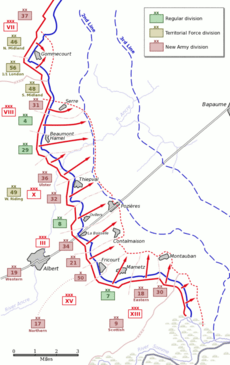Livens Large Gallery Flame Projector facts for kids
Quick facts for kids Livens Large Gallery Flame Projector |
|
|---|---|
 |
|
| Type | Flamethrower |
| Place of origin | United Kingdom |
| Service history | |
| In service | 1916–1917 |
| Used by | British Army |
| Wars | First World War |
| Production history | |
| Designer | William Howard Livens |
| Produced | 1915–1916 (?) |
| No. built | at least 5 (?) |
| Specifications | |
| Mass | 2.5 long tons (2.5 t) |
| Length | 56 feet (17 m) |
The Livens Large Gallery Flame Projector was a huge, experimental flamethrower used by the British Army during World War I. It was named after its inventor, a British officer named William Howard Livens.
Contents
History of the Flame Projector
The British Army used four of these giant flamethrowers in 1916 during the Battle of the Somme. Another one was used in 1917 near Diksmuide, Belgium.
Before the Battle of the Somme, British soldiers dug many underground tunnels. These tunnels were called "saps." They were meant to help the soldiers attack German lines. Four of these tunnels were secretly fitted with Livens Large Gallery Flame Projectors. The plan was to spray the German front line with "liquid fire."
To keep them safe, the flamethrowers were pulled into the tunnels just hours before the battle began. Two of these weapons were damaged by German shelling before they could be used. However, the other two were successfully used. They fired from tunnels near Carnoy.
Using these flamethrowers might have helped the British. In those areas, the British Army had fewer losses. One report even said that 50 German soldiers surrendered right after a Livens Flame Projector was used.
The weapon was used again in Belgium in 1917. But it was very hard to use. It took 300 men to bring it to the front lines and set it up. Filling it with fuel was also dangerous. After all that effort, it could only fire three short bursts. It was also easily damaged or buried by enemy shells. Because of these problems, the British Army stopped using it.
How the Flame Projector Worked
The Livens Large Gallery Flame Projector was about 56 feet (17 m) long. That's longer than a school bus! It weighed about 2.5 long tons (2.5 t), which is very heavy. It took 300 men to carry it to the front and put it together underground.
The weapon was hidden in a shallow tunnel dug under "no man's land" (the area between enemy trenches). It had several tanks filled with fuel. It also had a large pipe and a nozzle that would pop up to the surface.
A team of eight soldiers usually operated the flamethrower. When it was time to fire, a special air-powered cylinder pushed the nozzle up through the ground. Then, compressed gas pushed a piston inside the machine. This forced the fuel out of the underground tanks and through the nozzle. The fuel was then lit and sprayed at the target.
This powerful weapon could shoot flames up to 300 ft (90 m) away. But it could only fire three times, each burst lasting about ten seconds.
Finding the Old Flamethrowers
In May 2010, a team of historians and archaeologists found parts of one of these Livens Large Gallery Flame Projectors. They found it near Mametz, France. This discovery was part of a TV show called Time Team.
To understand how it worked, the Royal Engineers helped build a full-sized, working model of the weapon. This showed everyone how powerful it truly was!
In Popular Culture
Did you know that the Livens flame projector inspired a famous dragon? The fire-breathing dragon Smaug, from J. R. R. Tolkien's story The Hobbit, was partly inspired by this weapon. Filmmaker Peter Jackson used this idea for Smaug's fire-breathing in his movie The Hobbit: The Desolation of Smaug.



